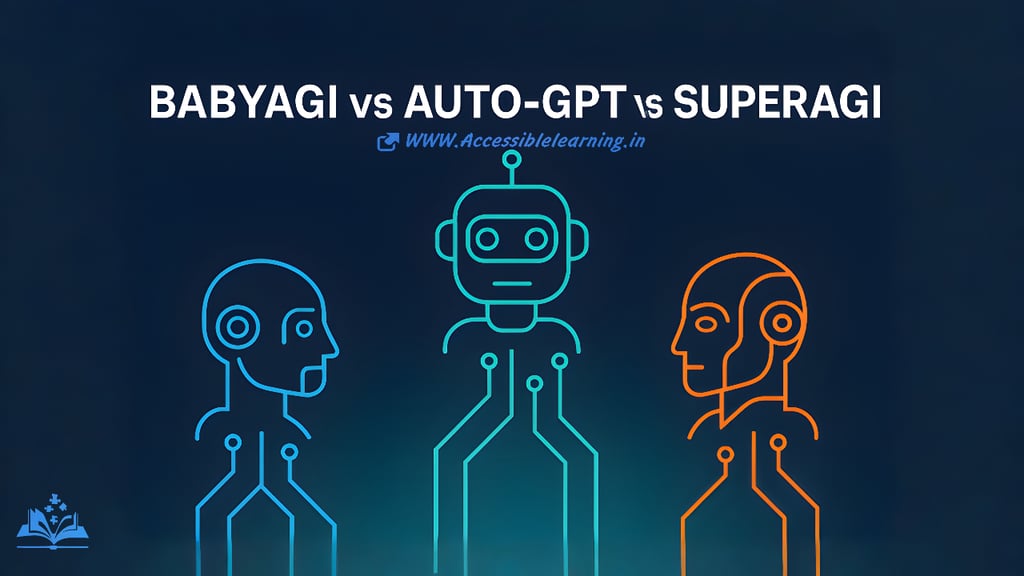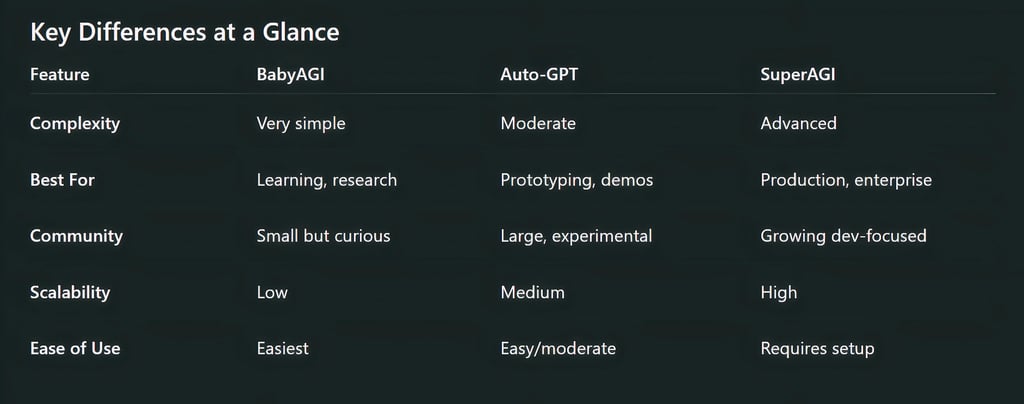
Which Autonomous Agent is Best? BabyAGI vs Auto-GPT vs SuperAGI Explained
Explore the differences between BabyAGI, Auto-GPT, and SuperAGI — three leading autonomous agent frameworks. Learn their technical strengths, use cases, memory systems, and best-fit scenarios to decide which AI agent suits your project, from simple experiments to enterprise-scale automation.
AI ASSISTANTAI/FUTUREEDITOR/TOOLS
Sachin K Chaurasiya
10/15/20255 min read


Artificial Intelligence is no longer limited to generating text or images on command — it’s moving into autonomous decision-making. At the center of this shift are autonomous agents, systems that can plan, execute, and learn with minimal human input.
Three of the most discussed frameworks in this space are BabyAGI, SuperAGI, and Auto-GPT. Each offers unique strengths, limitations, and use cases. If you’re exploring AI agents for research, prototyping, or production, understanding their differences is essential.
What is an Autonomous Agent?
An autonomous agent is an AI system powered by large language models (LLMs) that can:
Break down a high-level goal into smaller tasks.
Use tools like APIs, databases, or browsers to gather information.
Make decisions in loops until the main objective is completed.
Store memory and learn from past actions.
In simple terms, instead of asking an AI one question at a time, you can give it an end goal and let it figure out how to reach it.
BabyAGI: The Minimalist Learner
BabyAGI was created as a simple experimental project — the “baby” of autonomous agents. Its main purpose is to show how agents can generate tasks, prioritize them, and use memory to improve future decisions.
Strengths
Extremely lightweight and easy to understand.
Perfect for learning how task queues, memory, and loops work.
Simple to extend for small projects or research.
Weaknesses
Not designed for production.
Very limited tools and integrations.
Can’t handle large-scale, multi-agent tasks.
Best Use Cases
Education, personal experiments, AI research, and small automation tasks.
Auto-GPT: The First Big Leap
Auto-GPT gained fame as one of the first open-source autonomous agent frameworks. It allows GPT models to run independently, creating tasks, browsing the web, writing code, and analyzing results without step-by-step human guidance.
Strengths
Strong community support and many forks or plugins.
Easy to set up for quick experiments.
Great demonstration of what autonomous workflows can achieve.
Weaknesses
Often stuck in loops or hallucinations.
Consumes high amounts of API tokens (costly).
Not reliable for critical or long-term use.
Best Use Cases
Rapid prototyping, hobby projects, content research, market analysis, or automation demos.
SuperAGI: The Developer’s Framework
SuperAGI is more than an experiment — it’s a framework built for developers and businesses that want to integrate AI agents into real-world applications. Unlike BabyAGI or Auto-GPT, it comes with structured features, scalability, and enterprise focus.
Strengths
Developer-friendly with dashboards, monitoring, and logging.
Supports multiple agents working together.
Easy integration with tools like APIs, databases, and third-party apps.
Designed for scalability and long-term use.
Weaknesses
Larger codebase with a steeper learning curve.
Requires engineering setup and resources.
Still limited by the capabilities of LLMs.
Best Use Cases
Enterprise automation, SaaS product integration, research pipelines, or complex workflows needing reliability.



Safety, Cost, and Reliability
All three share common challenges:
LLM Dependence: Their success depends on the language model used (e.g., GPT-4 is far more reliable than GPT-3.5).
Cost: Continuous loops can consume tokens rapidly, so budget control is essential.
Safety Risks: Without proper constraints, they may make poor decisions or attempt unsafe tasks.
Reliability: They may get stuck or repeat tasks endlessly unless given human oversight or validation rules.
Choosing the Right Agent
Pick BabyAGI if you want to learn how AI agents work or run small, educational experiments.
Pick Auto-GPT if you want to prototype quickly and explore autonomous workflows with minimal setup.
Pick SuperAGI if you’re a developer or business looking to build production-grade AI systems with integrations and scalability.
Programming Language & Frameworks
BabyAGI
Primarily written in Python.
Lightweight dependencies — often just OpenAI API, LangChain, and a vector database.
Small codebase (under a few hundred lines in early versions).
Auto-GPT
Written in Python, but many forks exist in JavaScript/TypeScript.
Uses LangChain and optional tools for file I/O, APIs, and memory.
Plug-in ecosystem allows integration with browsers, APIs, and external services.
SuperAGI
Written in Python, built as a framework-first project.
Includes FastAPI backend for serving agents.
Offers dashboard/UI for monitoring and controlling agents.
Strong plugin architecture with modular toolkits.
Memory Handling
One of the biggest technical challenges in autonomous agents is how they handle “memory.”
BabyAGI
Uses vector databases (like Pinecone, Weaviate, FAISS) to store task embeddings.
Keeps memory minimal — retrieval is focused only on relevant past tasks.
Auto-GPT
Memory can be short-term (within the loop) and long-term (vector DB).
Some forks added support for Redis or PostgreSQL for persistence.
Struggles with “forgetting” irrelevant tasks, leading to unnecessary loops.
SuperAGI
Advanced memory architecture with short-term, long-term, and episodic storage.
Supports multiple vector DB integrations.
Offers memory management APIs for developers to control how agents recall or discard information.
Task Orchestration & Execution
BabyAGI
Uses a task queue (priority-based).
One task at a time → generate → execute → re-prioritize.
Minimal orchestration, designed for clarity.
Auto-GPT
Goal-driven loop: plan → execute → reflect → repeat.
Capable of recursive self-calls, but prone to infinite loops.
Execution often relies on tools like requests, BeautifulSoup, or Python subprocesses.
SuperAGI
Built for multi-agent orchestration.
Agents can run concurrently and collaborate.
Has scheduler support for timed or parallel tasks.
Includes human-in-the-loop checkpoints where developers can approve/reject steps.
Tooling & Integrations
BabyAGI
Only minimal tools by default — developers add integrations manually.
Usually paired with simple APIs or web scraping tools.
Auto-GPT
Community-driven plugin ecosystem (e.g., web browsing, APIs, spreadsheets, crypto wallets).
Often requires careful API key management in .env files.
SuperAGI
Comes with toolkits out-of-the-box (GitHub, Trello, Slack, DBs, etc.).
Offers a Tool Registry where developers can publish/share tools.
Built-in safety sandboxing (e.g., restricting file access or API misuse).
Deployment & Infrastructure
BabyAGI
Lightweight → can run locally on a laptop.
Often just a Python script using the OpenAI API.
Auto-GPT
Can run locally, on servers, or in containers.
Many community-hosted versions exist, but deployment at scale is messy.
Not designed for production monitoring.
SuperAGI
Designed with cloud deployment in mind.
Supports Docker and Kubernetes for scaling.
Offers API endpoints so agents can be embedded into SaaS platforms.
Better for enterprise/production environments.

Security & Safety Controls
BabyAGI
No real safety layer — left to the developer.
If given dangerous tools, it will use them without restrictions.
Auto-GPT
Basic confirmation prompts for sensitive tasks (like file deletion).
Some forks added “sandbox mode” to prevent unsafe actions.
SuperAGI
Explicit permission systems for tools.
Developers can whitelist/blacklist tasks.
Supports audit logs to track what the agent did and why.
Performance & Scalability
BabyAGI
Best suited for single-threaded, small tasks.
No concurrency support.
Auto-GPT
Moderate scalability but quickly consumes resources.
Long tasks often fail due to loop inefficiency.
SuperAGI
Designed for scalability and concurrency.
Multiple agents can run in parallel.
Built-in monitoring prevents runaway processes.
Ecosystem & Community
BabyAGI: Small but innovative — used by researchers to test new memory and reasoning techniques.
Auto-GPT: Large and experimental — countless forks, rapid testing ground for ideas.
SuperAGI: Developer-driven — focus on stable frameworks, structured contributions, and professional tooling.
The Future of Autonomous Agents
The future of BabyAGI, Auto-GPT, and SuperAGI points toward:
Better tool ecosystems for real-world use.
Improved guardrails and safety checks.
More reliable multi-agent collaboration.
Reduced costs with optimized loops and memory systems.
As LLMs get more powerful, frameworks like SuperAGI will likely dominate production environments, while BabyAGI and Auto-GPT remain crucial testbeds for new ideas and experimentation.
BabyAGI is a lightweight sandbox for learning.
Auto-GPT is the experimental playground for fast prototyping.
SuperAGI is the professional framework built for production.
Your choice depends on whether you value simplicity, speed, or scalability.
FAQs
Q: Are these true Artificial General Intelligence (AGI)?
No. Despite the names, they are not AGI. They are frameworks that use today’s LLMs to act autonomously within limits.
Q: Which one is easiest to start with?
BabyAGI is the easiest and lightest to set up, followed by Auto-GPT for quick experiments.
Q: Which one is best for businesses?
SuperAGI — it’s built with production workflows, monitoring, and scalability in mind.
Q: How can I control costs?
Set action caps, use budget-friendly models for basic tasks, and monitor token usage carefully.
Q: Can I use them for real-world automation?
Yes, but with caution. Always test in sandbox environments first, add safety rules, and supervise outputs.
Subscribe to our newsletter
All © Copyright reserved by Accessible-Learning
| Terms & Conditions
Knowledge is power. Learn with Us. 📚


